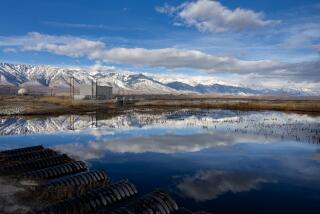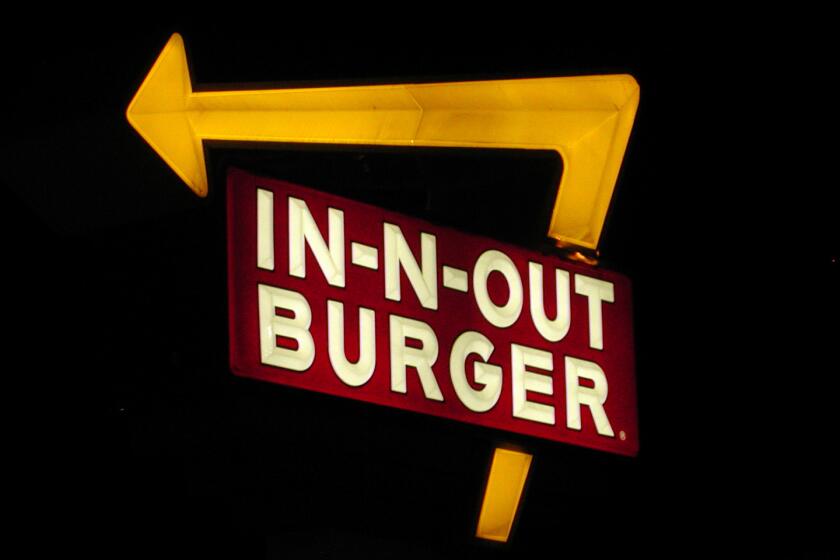Long Beach water use restrictions are dripping success
- Share via
Since Long Beach ordered mandatory curbs on water use this fall, its Water Department has turned to unorthodox tools to spread the word.
“STOP Wasting Water,” urge the crimson warnings on the front pages of local weekly newspapers.
A YouTube video, shot hidden camera-style on a Long Beach street, shows water shooting from a broken lawn sprinkler as a timer ticks off the minutes to the dramatic chords of Beethoven’s Ninth Symphony. The caption: “Come on. . . . Enough is enough. CONSERVE.”
Kevin Wattier, the department’s general manager, has even invited journalists to his home to see how he ripped out his lawn in favor of drought-tolerant plants, tile and artificial turf.
Water demand is outstripping supply in the region, Wattier says, and it’s time for permanent change. “We’ve gone through a tipping point. This is not a temporary thing. This is a lifestyle change,” he said.
The approach is working.
Water consumption has dropped markedly in the three months since Long Beach became the first sizable city in California to mandate restrictions, city reports show.
September water use set a 10-year record low, dropping 8% from the same month last year. It fell 5% in October and 6% in November, another record.
The department designed the campaign in-house with a $70,000 budget and a two-person communications staff.
By contrast, Los Angeles water use rose almost 1% in the five months after Mayor Antonio Villaraigosa’s June 6 call for a 10% voluntary cut. The San Diego County Water Authority saw disappointing results with its “20-gallon challenge,” a call for each resident to conserve 20 gallons daily.
“These things do take time,” said Ken Weinberg, director of water resources for the authority, which plans to increase its advertising. Los Angeles may opt for stronger measures, and Pasadena is set to announce a new conservation program today.
In Long Beach, much of the credit goes to residents who have cut back on lawn watering, Wattier said. Watering is allowed only three days a week, only at night and only for 10 minutes.
Using regular hoses to wash sidewalks, patios and parking lots is also banned, a point driven home in another YouTube video that shows a woman hosing down a driveway, with a yellow smiley-face logo added to shield her identity.
Instead of ticketing, the department relies on tipsters to anonymously report scofflaw watering.
The first offense brings a polite letter, the second a personal visit. Few residents violate the rules twice, said Ryan Alsop, the department’s director of government and public affairs.
Such success stands out amid mounting water woes.
An eight-year drought has significantly lowered the Colorado River, and snowpack remains slight in the Sierra Nevada.
And on Friday, a U.S. District Court judge in Fresno issued a final order intended to protect the endangered Delta smelt that will reduce water deliveries to Southern California by as much as 30%.
Worried cities are paying close attention to the state’s largest water wholesaler, the Metropolitan Water District of Southern California, which receives water from the north and the Colorado River and sells it to 26 member agencies from Ventura to San Diego.
Los Angeles is currently buying a historic high of 75% of its water from the MWD, compared with 34% in years when Eastern Sierra water was more plentiful.
Long Beach gets 50% of its water from the MWD; Santa Monica, 85%; Pasadena, 60%; Anaheim, 22%; and Santa Ana, 18%.
The MWD already has announced a 30% cut in water supplies for farmers and is planning how it would allot water to each agency if necessary. That could lead to widespread mandatory curbs.
“We don’t want to do it prematurely, but we want to have a plan in place,” said Stephen Arakawa, manager of the MWD water resource management group.
Some area water officials worry that if they impose cuts now and mountain snowfall is abundant, they will be accused of “crying wolf.”
Water expert Peter Gleick, co-founder and president of the Pacific Institute in Oakland, says he is frustrated with what he labels the wait-and-see attitude of the MWD, Los Angeles and others.
“ ‘Let’s wait. Let’s wait.’ It’s sort of the pray-for-rain mentality,” Gleick said.
While he does not favor mandatory curbs as a first step, he said, cities that respond early to shortages can better educate people on how to conserve and invest in water-saving household appliances and landscapes.
“I think we ought to be doing things immediately. If the current winter is dry, I think it could be bad. We’re going to be really sorry we didn’t do things a year ago,” Gleick said.
Long Beach officials concluded that they should act sooner rather than later.
Government in the waterfront city of about 473,000 is moderate, even staid, but its Water Department is known for independence and innovation.
The department operates separately from City Hall, freeing it from most political pressure. It has its own desalination research facility, and reclaimed water accounts for nearly 9% of its water supply, compared with 1% in Los Angeles.
Wattier, who has served as general manager for the last six years, is a civil and environmental engineer by training. He spent 13 years at the MWD, where he was assistant chief of operations.
As the water picture worsened last April, Long Beach water managers adopted a “no regrets” philosophy. If the water outlook improved and their plans proved unnecessary, the worst thing would be that residents would save on their water bills.
Managers brainstormed around a table at the department’s modest East Wardlow Road building. They considered a poster contest but wanted something more urgent.
The edginess of anti-smoking advertising campaigns became a model. The goal: to reach the resident who goes out at midday to water the yard with a hose in hand, and make him feel too guilty to turn on the hose.
The campaign has no pricey television commercials. Conservation spots run on 14 cable channels, and residents can choose to receive “e-watering updates” via e-mail. Free courses teach gardeners how to conserve. Car dealerships show water alerts on lighted signs along the San Diego Freeway.
Having residents report water waste is key, Alsop said. Although some dislike the approach, he said, others wanted to alert city officials rather than approaching neighbors on their own.
The campaign underscores personal responsibility, he said.
Joseph Ramallo, spokesman for the Los Angeles Department of Water and Power, said the Long Beach campaign has benefited from that city’ smaller size. The city hugs the coast, enjoying lower temperatures than the San Fernando Valley, and its lot sizes are smaller, he said.
Ramallo said heavy commercial and industrial water use might be skewing Los Angeles’ water use statistics, masking efforts by residents to conserve.
Long Beach’s restrictions apply to both residences and businesses. The department works closely with the Chamber of Commerce, and businesses are conserving, Wattier said.
Wattier voices no regrets about the stern message he is delivering to neighborhood associations, civic groups and the City Council.
“We show that graph that the three reservoirs in Northern California are the lowest since 1992. We say that we lost enough water from the Colorado River in 2003 for 3 million people.
“It convinces people that this is absolutely necessary.”
deborah.schoch@latimes.com
More to Read
Inside the business of entertainment
The Wide Shot brings you news, analysis and insights on everything from streaming wars to production — and what it all means for the future.
You may occasionally receive promotional content from the Los Angeles Times.










